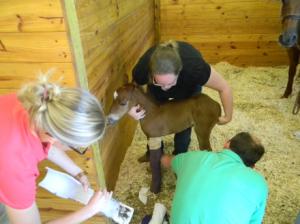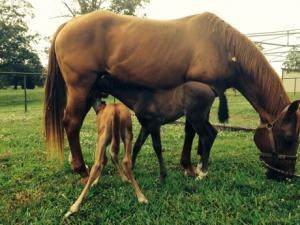By Cori Webb
Deciding to have a foal is the first and arguably easiest step in the foaling process. Then come the more difficult tasks of choosing the perfect pairing of mare and stallion, ensuring a successful conception, and maintaining a healthy pregnancy. Then after the months of care and waiting, when a new foal finally arrives on the farm, it is an exciting and joyous moment for horses’ owners and caretakers. But what do you do when not one, but two foals make an appearance? While twinning in horses is rare, it can be an extremely dangerous occurrence for the mare and foals involved. Recently, however, one lucky set of twins beat the odds!
Partys Playgirl, a Quarter Horse mare owned by Janie and Mike Akin of Counce, Tennessee, was sent in the spring of 2013 to JW Ranch in Slayden, Mississippi to be bred to Alittle Street Smart, owned by Tricia and Joe Wright. A year later, Playgirl was brought back to JW Ranch around early May to foal at the ranch. Three weeks past her due date, Playgirl kept her labor a secret from her caretakers, and gave birth in the pasture during the middle of the day. Not only was her mid-day foaling a surprise, but also finding a pair of foals was a real shock for the Wright’s. “How she birthed those [foals] in forty-five minutes to an hour and fifteen minutes, on her own…! So often they say they try to present at the same time and kill the mare, and both of them die,” Tricia exclaimed, still amazed by the event that unfolded on her farm.
The Wrights immediately called Dr. Megan Hunt of Equine Veterinary Associates of Olive Branch, Mississippi to inform her about the foals. Both foals were alert, stood within a reasonable time frame, and began nursing adequately, which was a relief for both the Wrights and Dr. Hunt to see. The morning after their birth, Dr. Hunt went to the Wrights to evaluate the foals. “I did physical exams, looking at eyes, listening to hearts, checking umbilicus, you know – just looking at them,” explains Dr. Hunt, who followed up with blood work to check the foals’ immune systems. The smaller of the two foals, Rudy, came back with poor levels and required plasma treatment to boost his immune system. Rudy and Trouble, his bigger brother, were both diagnosed with angular limb deformities, due to the lack of room in the mare’s uterus during gestation. Often times, foals suffering from angular limb deformities can see improvement from exercise and time, or in severe cases, confinement and time. In Rudy’s case, his condition worsened as time went on, and it became evident that he would need assistance in correcting his leg structure.
“We took radiographs to evaluate how severe his lack of development was, then consulted with surgeons. We decided to splint him to try to give him some support while he develops more, until he can get big enough to put screws in his legs to help straighten them,” Dr. Hunt states. Rudy continues to improve from the use of the splints, and he and his brother both have very positive prognoses from Dr. Hunt. “Once we can get Rudy to grow enough and be strong enough, honestly, they have just as much chance of being performance horses as any other foal born with angular deformities.” Rudy and Trouble are expected to undergo their corrective surgeries when they have reached the age of one month.
Twinning in mares typically occurs when two follicles release eggs at nearly the same time, resulting in the potential for both eggs to become fertilized. Twinning is a dangerous occurrence for horses, as they are not designed to carry two full-size foals at once. Occasionally the mare may naturally reabsorb one embryo in a set of twins during early gestation, leaving little evidence that there were ever two foals in the first place. When one embryo is not reabsorbed, the twins begin to compete for nutrients and uterine space, often leading to poor development of one or both foals, early parturition, and in most cases, death of one or both foals.
Twinning is preventable through early reproductive assessment by a veterinarian. In most cases, a veterinarian will suggest performing an ultrasound on the mare around day fourteen of gestation to detect the presence of an embryo, or more than one. If twins are found, there are some options that the veterinarian and owners can discuss to address the issue.
“With twins, usually, you don’t get two live foals. That’s extremely rare and, honestly, almost a miracle,” says Dr. Hunt. “We are well on our way to having a good outcome for both foals in this situation, and that’s great.”
Deciding to have a foal is the first and arguably easiest step in the foaling process. Then come the more difficult tasks of choosing the perfect pairing of mare and stallion, ensuring a successful conception, and maintaining a healthy pregnancy. Then after the months of care and waiting, when a new foal finally arrives on the farm, it is an exciting and joyous moment for horses’ owners and caretakers. But what do you do when not one, but two foals make an appearance? While twinning in horses is rare, it can be an extremely dangerous occurrence for the mare and foals involved. Recently, however, one lucky set of twins beat the odds!
Partys Playgirl, a Quarter Horse mare owned by Janie and Mike Akin of Counce, Tennessee, was sent in the spring of 2013 to JW Ranch in Slayden, Mississippi to be bred to Alittle Street Smart, owned by Tricia and Joe Wright. A year later, Playgirl was brought back to JW Ranch around early May to foal at the ranch. Three weeks past her due date, Playgirl kept her labor a secret from her caretakers, and gave birth in the pasture during the middle of the day. Not only was her mid-day foaling a surprise, but also finding a pair of foals was a real shock for the Wright’s. “How she birthed those [foals] in forty-five minutes to an hour and fifteen minutes, on her own…! So often they say they try to present at the same time and kill the mare, and both of them die,” Tricia exclaimed, still amazed by the event that unfolded on her farm.
The Wrights immediately called Dr. Megan Hunt of Equine Veterinary Associates of Olive Branch, Mississippi to inform her about the foals. Both foals were alert, stood within a reasonable time frame, and began nursing adequately, which was a relief for both the Wrights and Dr. Hunt to see. The morning after their birth, Dr. Hunt went to the Wrights to evaluate the foals. “I did physical exams, looking at eyes, listening to hearts, checking umbilicus, you know – just looking at them,” explains Dr. Hunt, who followed up with blood work to check the foals’ immune systems. The smaller of the two foals, Rudy, came back with poor levels and required plasma treatment to boost his immune system. Rudy and Trouble, his bigger brother, were both diagnosed with angular limb deformities, due to the lack of room in the mare’s uterus during gestation. Often times, foals suffering from angular limb deformities can see improvement from exercise and time, or in severe cases, confinement and time. In Rudy’s case, his condition worsened as time went on, and it became evident that he would need assistance in correcting his leg structure.
“We took radiographs to evaluate how severe his lack of development was, then consulted with surgeons. We decided to splint him to try to give him some support while he develops more, until he can get big enough to put screws in his legs to help straighten them,” Dr. Hunt states. Rudy continues to improve from the use of the splints, and he and his brother both have very positive prognoses from Dr. Hunt. “Once we can get Rudy to grow enough and be strong enough, honestly, they have just as much chance of being performance horses as any other foal born with angular deformities.” Rudy and Trouble are expected to undergo their corrective surgeries when they have reached the age of one month.
Twinning in mares typically occurs when two follicles release eggs at nearly the same time, resulting in the potential for both eggs to become fertilized. Twinning is a dangerous occurrence for horses, as they are not designed to carry two full-size foals at once. Occasionally the mare may naturally reabsorb one embryo in a set of twins during early gestation, leaving little evidence that there were ever two foals in the first place. When one embryo is not reabsorbed, the twins begin to compete for nutrients and uterine space, often leading to poor development of one or both foals, early parturition, and in most cases, death of one or both foals.
Twinning is preventable through early reproductive assessment by a veterinarian. In most cases, a veterinarian will suggest performing an ultrasound on the mare around day fourteen of gestation to detect the presence of an embryo, or more than one. If twins are found, there are some options that the veterinarian and owners can discuss to address the issue.
“With twins, usually, you don’t get two live foals. That’s extremely rare and, honestly, almost a miracle,” says Dr. Hunt. “We are well on our way to having a good outcome for both foals in this situation, and that’s great.”














